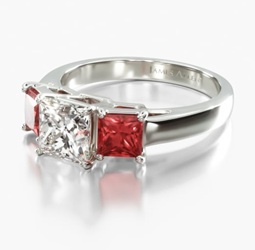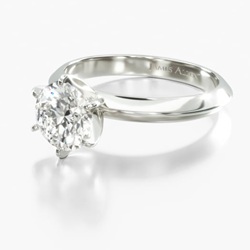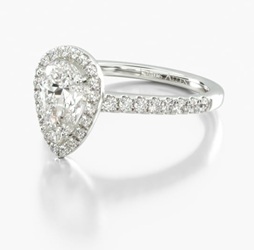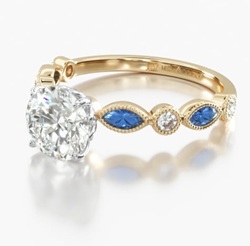Table Of Contents.
- 1) How Does Diamond Shape Influence Its Price?
- 2) The Importance of Diamond Shape in Pricing
- 3) Why Round Diamonds Are Typically More Expensive
- 4) Why Do Some Diamonds Have Higher Prices Than Others?
- 5) Diamond Shape vs. Price Comparison
- 6) What Makes Round Diamonds the Most Expensive Shape?
- 7) What Is the Most Affordable Diamond Shape?
- 8) What Makes Each Diamond Shape Stand Out? Exploring Unique Traits
GIA 1.68 Carat J-SI2 Princess Cut Diamond Three Stone Princess Shaped Ruby Engagement Ring |

|
| Click on the Image |
|
|
1) How Does Diamond Shape Influence Its Price?Back To Top |
Explore how diamond shape plays a vital role in determining its price. From classic round cuts to modern choices like radiant and marquise cuts, understand how different shapes affect cost. This guide will help you make a well-informed decision for your engagement ring or fine jewelry piece.
|
|
2) The Importance of Diamond Shape in Pricing.Back To Top |
When buying a diamond, the shape you choose directly impacts its price. Round diamonds, known for their timeless appeal, tend to be pricier than other shapes due to high demand, intricate cutting requirements, and their unmatched brilliance. In comparison, fancy shapes—such as oval, cushion, and pear—usually come at a lower cost.
|
|
3) Why Round Diamonds Are Typically More Expensive.Back To Top |
Round diamonds are the most popular and sought-after shape, which naturally drives up their price. Additionally, crafting a round diamond often involves higher manufacturing costs due to the amount of rough diamond that’s lost during the cutting process. The round shape’s superior sparkle and brilliance also contribute to its premium price tag, making it a top choice despite the cost.
|
|
4) Why Do Some Diamonds Have Higher Prices Than Others?Back To Top |
Round diamonds are both the most popular and the most expensive. This higher cost stems from the cutting process, which leads to greater waste and requires more rough diamond material. Although they come at a lower price, princess and cushion cuts remain popular due to their unique faceting styles.
Elongated shapes, such as oval and emerald cuts, have fewer facets but deliver impressive clarity, making them a more affordable option. The most budget-friendly choices are pear and marquise shapes. While less common, they are excellent options for those who appreciate distinctive and elegant diamond shapes.
IGI Lab-Grown 1.27 Carat D-VVS2 Emerald Cut Diamond Petite Pave Engagement Ring (Flush Fit) |

|
| Click on the Image |
|
|
5) Diamond Shape vs. Price Comparison.Back To Top |
Explore this comparison of 1-carat diamonds across various shapes. Here, you’ll find a breakdown of the price variations between lab-grown and earth-mined diamonds, each featuring a G color grade and VS1 clarity.
|
|
6) What Makes Round Diamonds the Most Expensive Shape?Back To Top |
Round diamonds stand as both the most popular and the priciest diamond shape. They are approximately 65% more expensive than other shapes, making them a premium choice. Here are some key benefits of selecting a round cut diamond.
Exceptional Brilliance.
Round diamonds lead in sparkle, thanks to their unmatched brilliance. This dazzling effect results from their unique faceting, designed to maximize light reflection.
Timeless Versatility.
A round diamond fits seamlessly with both vintage and modern settings. Its classic appeal has made it a lasting favorite that complements any jewelry style.
IGI Lab-Grown 1.54 Carat E-VS2 Oval Cut Diamond Three Stone Pear Shaped Engagement Ring |

|
| Click on the Image |
Premium Value and Rarity.
Round diamonds are considered luxury items due to their rarity. This scarcity also helps them retain strong long-term value, adding appeal for investment-minded buyers.
Precision in Cut Quality.
Round diamonds benefit from a specialized grading system that ensures precision and consistency in cut quality. This standardized grading adds an extra level of assurance for those seeking a premium stone.
Superior Light Reflection.
Round diamonds are crafted to reflect the maximum amount of light, giving them an extraordinary sparkle that catches the eye and enhances their luxurious appearance.
Greater Tolerance for Inclusions
The symmetrical design of a round diamond makes it more forgiving of minor imperfections or inclusions. This symmetry helps round diamonds appear flawless to the unaided eye.
In summary, those seeking a traditional yet versatile diamond with stunning brilliance and high value should consider a round cut diamond. Its timeless appeal, radiant sparkle, and solid investment potential make it a top choice among diamond shapes.
GIA 0.71 Carat F-VS1 Excellent Cut Round Diamond Presentation Solitaire (Six Prong) Engagement Ring |

|
| Click on the Image |
|
|
7) What Is the Most Affordable Diamond Shape?Back To Top |
Pear and marquise cuts are typically the most affordable diamond shapes. These shapes are less popular than round, princess, and cushion cuts, making them a budget-friendly option for those seeking value.
How Price Is Affected by the 4Cs.
While pear and marquise diamonds are often cheaper, their final price still depends on the 4Cs: carat weight, color, clarity, and cut quality. These factors play a significant role in the diamond’s value, meaning that even within affordable shapes, the cost may vary based on these qualities.
Why Pear and Marquise Diamonds Are Great for Budget-Conscious Shoppers.
For those on a budget, pear and marquise cuts offer a distinctive look without the high price. These shapes provide a unique, eye-catching form that remains elegant, making them a smart choice for those seeking style and affordability in one package.
IGI 1.06 Carat F-SI1 Pear Shaped Diamond Pave Halo and Shank Diamond Engagement Ring |

|
| Click on the Image |
|
|
8) What Makes Each Diamond Shape Stand Out? Exploring Unique Traits.Back To Top |
Round Diamonds Are the Most Sought-After and Expensive.
Round diamonds lead as the most popular and desirable diamond shape—and for a good reason! They come with a higher price tag due to their exceptional brilliance, precise cut, and high demand. The process of creating round diamonds requires more of the rough stone, resulting in greater material waste, which drives up production costs.
IGI 1.12 Carat G-VVS2 Excellent Cut Round Diamond Vintage Round Diamond and Marquise Sapphire Engagement Ring |

|
| Click on the Image |
Princess Cut Diamonds: Modern Brilliance
Princess cut diamonds offer similar sparkle and fire to round diamonds but come at a lower price. This trendy, contemporary cut features a unique faceting style that enhances the diamond’s size appearance, adding to its appeal and perceived value without the cost of a round cut.
GIA 1.05 Carat D-VS1 Princess Cut Diamond 0.25ct Channel Set Princess Shaped Diamond Engagement Ring |

|
| Click on the Image |
Cushion Cut Diamonds: Timeless Elegance with a Vintage Touch
Cushion cut diamonds bring a touch of vintage charm, especially when set in a halo. With their classic appeal, these diamonds resemble princess cuts in appearance and aren’t too far off in price. Cushion cuts feature larger facets that give off a soft, romantic glow, adding to their allure and making them a highly valued choice.
GIA 0.71 Carat E-VS2 Cushion Cut Diamond Double Claw Prong Engagement Ring |

|
| Click on the Image |
| GIA Lab-Grown 1.26 Carat F-VVS2 Emerald Cut Diamond Octagon Halo Diamond Engagement Ring |
|---|

|
| Click on the Image |
Read More About Diamond Shapes.
| Baguette Diamonds | Marquise Diamond |
| Princess Cut Diamonds | Round Brilliant Diamond |
| Asscher Cut Diamond | Emerald Cut Diamond |